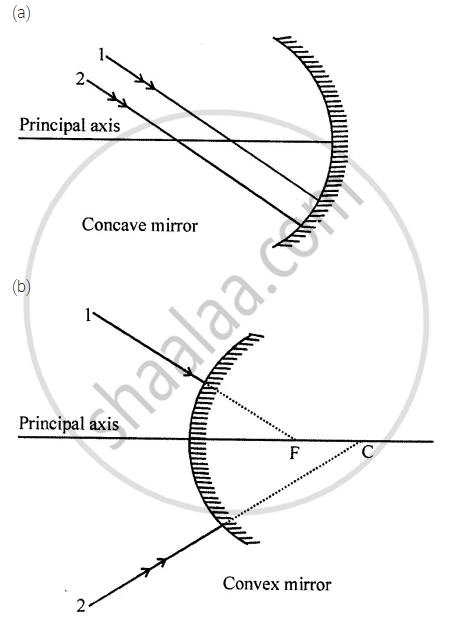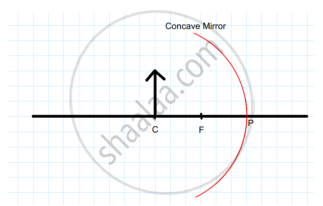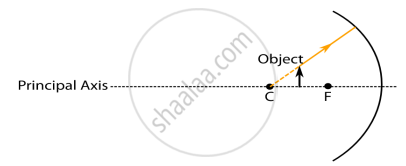Advertisements
Advertisements
प्रश्न
In which equipment/s do you find ___________________
उत्तर
(i) Concave mirror is found in torches, headlights, flood lights, solar devices,dentist's mirror.
(ii) Convex lens is used in simple microscope, compound microscope, telescopes, optical instruments and spectacles.
(iii) Reflecting mirrors are used in projector lamps, telescopes.
APPEARS IN
संबंधित प्रश्न
"A concave mirror of focal length 15 cm can form a magnified, erect as well as inverted image of an object placed in front of it." Justify this statement stating the position of the object with respect to the pole of the mirror in both the cases for obtaining the images.
Draw the following diagram in which a ray of light is incident on a concave/convex mirror on your answer sheet. Show the path of this ray, after reflection, in each case.

To construct a ray diagram we use two rays of light which are so chosen that it is easy to determine their directions after reflection from the mirror. Choose these two rays and state the path of these rays after reflection from a concave mirror. Use these two rays to find the nature and position of the image of an object placed at a distance of 15 cm from a concave mirror of focal length 10 cm.
List four specific characteristics of the images of the objects formed by convex mirrors.
Name the mirror that can give an erect and enlarged image of an object.
Find the focal length of a concave mirror whose radius of curvature is 32 cm.
Draw diagram to represent the action of a concave mirror on a beam of parallel light rays. Mark on this diagram principal axis, focus F, centre of curvature C, pole P and focal length f, of the concave mirror.
If an object is placed at the focus of a concave mirror, where is the image formed?
Draw a ray diagram showing how a concave mirror can be used to produce a real, inverted and diminished image of an object.
Draw ray-diagrams to show the formation of images when the object is places in front of a concave mirror (converging mirror):
(i) between its pole and focus
(ii) between its centre of curvature and focus
between its pole and focus
Describe the nature, size and position of the image formed in each case.
State one use of concave mirror bases on the formation of image as in case (i) above.
The real image formed by a concave mirror is smaller than the object if the object is:
(a) between centre of curvature and focus
(b) at a distance greater than radius of curvature
(c) at a distance equal to radius of curvature
(d) at a distance equal to focal length
According to the "New Cartesian Singh Convention" for mirrors, what sign has been given to the focal length of:
a convex mirror?
One of the following does not apply to a concave mirror this is:
(a) focal length is negative
(b) image distance can be positive or negative
(c) image distance is always positive
(d) height of image can be positive or negative
Write down a formula for the magnification produced by a concave mirror.
in terms of height of object and height of image
An object is 24 cm away from a concave mirror and its image is 16 cm from the mirror. Find the focal length and radius of curvature of the mirror, and the magnification of the image.
Which of the following can make a parallel beam of light from a bulb falls on it?
(a) concave mirror as well as concave lens
(b) convex mirror as well as concave lens
(c) concave mirror as well as convex lens
(d) concave mirror as well as convex lens
If the radius of curvature of a concave mirror is 20 cm, its focal length is:
Complete the following diagrams in figure by drawing the reflected rays for the incident rays 1 and 2 if F is the focus and C is the centre of curvature.

Draw a ray diagram to show the formation of image of an object placed between the focus and centre of curvature of a concave mirror. State the position, size and nature of the image.
How can a concave mirror be used to obtain a virtual image of an object? Draw a diagram to illustrate your answer.
In the following diagram. MM' is a concave mirror and AB is an object. Draw on your answer-sheet a ray diagram to show the formation of image of this object.
Answer the following question:
An object is placed at a distance of 30 cm from a concave lens of focal length 30 cm.
(i) Use the lens formula to determine the distance of the image from the lens.
(ii) List four characteristics of the image (nature, position, size, erect/inverted) in this case.
(iii) Draw a labelled diagram to justify your answer of the part (ii)
Give any two applications of a concave and convex mirror.
State whether true or false. If false, correct the statement.
When an object is at the centre of curvature of concave mirror the image formed will be virtual and erect.
According to cartesion sign convention, which mirror and which lens has negative focal length?
Rays from Sun converge at a point 15 cm in front of a concave mirror. Where should an object be placed so that size of its image is equal to the size of the object?
An object at a distance of 30 cm from a
concave mirror gets its image at the same point. The focal length of the mirror is ______.
A concave mirror of focal length 20 cm forms an image having twice the size of object. For the virtual position of object, the position of object will be at ______.

Examine the above figure and state which of the following option is correct? [one small box in the figure is equal to 1 cm]

While looking at the above diagram, Nalini concluded the following.
- the image of the object will be a virtual one.
- the reflected ray will travel along the same path as the incident ray but in opposite direction.
- the image of the object will be inverted.
- this is a concave mirror and hence the focal length will be negative.
Which one of the above statements are correct?
An image formed by a lens is erect. Such an image could be formed by a
In torches, searchlights, and headlights of vehicles, the bulb is placed ______ of the concave mirror.
The focal length of a concave mirror is 5cm. Its radius of curvature is ______.
Write the uses of the concave mirror.
